

Home » What to expect from a bike fit – our fly on the wall report!
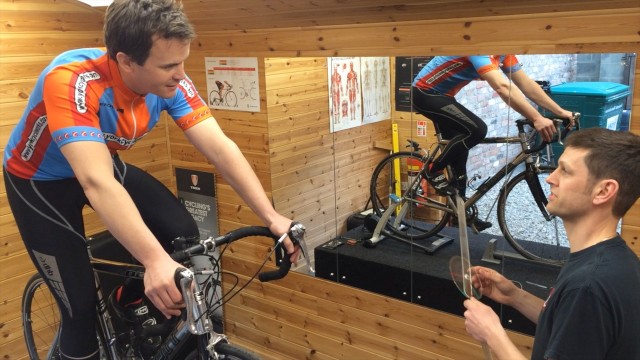
Cycling is widely regarded as a great low impact sport as it puts minimal pressure and stress on your joints – however, if your bike isn’t set up properly to your individual requirements it can cause injuries. (I know this from personal experience after I had a lot of problems with my hips because as a novice, I tried, but failed to fit my bike myself!) Getting your bike fitted properly can also ensure that you make the most out of cycling and ensure you as efficient as possible.
One of our Ride25 pioneers, James Craven, who has been cycling for 4 years and never had his bike fitted properly, decided that before he embarks on the Geneva to Milan Ride25 leg in June, he needed to get a proper bike fit. So James went along to see Sam Stretton at York Cycleworks (and as Ride25 are nosy parkers, we went along too to be a fly on the wall to record exactly what happens at a a professional bike fitting!) Here’s how we got on‚Ķ.
James had an appointment with Sam Stretton, a director at Cycleworks and who is accredited with the highly regarded Trek Fit Services Level 2, a course which is run by Cycle Fit of London.
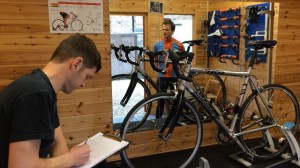
Sam kicked off with a fact-finding chat with James – his riding background, any injuries he had sustained in the past and any physical niggles or pains he had when cycling. Sam uncovered that James cycled on average about 2 times a week, with a long 60 mile ride at the weekend and that he had a few issues such as pins and needles in his hands, cramps in his quads when cycling and that he has had his left hip replaced. James had also never had his bike fitted before and had bought the bike second-hand from a friend, fitting the pedals etc himself.
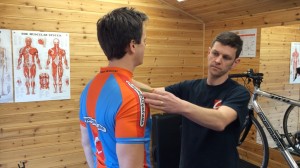
Next step on Sam’s list was a physical examination of James and key measurements of his body. He first measured his inside leg (I tried but failed at this point to stifle a giggle – with flashes of ‘Suits you, Sir’ spontaneously entering my brain!) and then moved on to measuring his shoulders and finally Sam conducted a standing observation of James’ body to check his alignment and body symmetry.
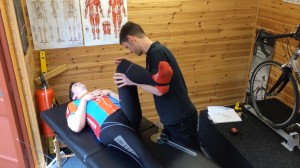
Sam then asked James to lie down on the physio’s bench for an assessment of his flexibility. He mainly checked his hamstrings and hip flexors (finding that the replaced hip had slightly less flexibility, not surprisingly, but in general was very good for someone with a hip replacement).
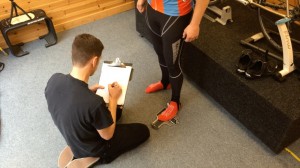
Sam then measured James’ feet and arches (telling him that he had ‘very good arches’, which James was clearly very pleased with himself about!) and then inspected his cleats on the bottom of his shoes. Sam explained that cleats can withstand about 5000km of cycling and James had clearly reached this as his cleats were really worn down and in need of replacement which Sam did for him there and then.
Interestingly, Sam said that almost everyone he sees for a bike fit has their cleats positioned in the wrong place. Cleats that are poorly positioned can cause various lower leg issues and if your cleats don’t allow your foot to flow naturally, you are more likely to suffer from knee problems. The aim, Sam said, is to get them positioned correctly so that they work as efficiently as possible.
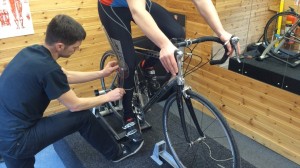
Sam then asked James to hop on his bike to inspect his riding position. Whilst pedalling away with his bike on the turbo turner, Sam inspected every part of James’ body and positioning. He asked James to lean forward and put his hands right in the hood. From this, Sam discovered that James was over-stretching as he was having to reach too far forward into the hood, which meant that it wasn’t comfortable for James to cycle for long periods in this position – James confirmed this.
Sam then asked James to put his pedals in a horizontal position for him to check his K.O.P.S (Knee over pedal spindle) which would indicate whether James’ saddle was in the correct position or not. Sam checked the plumb line straight down from James’ knee to the spindle of the pedal. According to K.O.P.S principle, if the saddle is in the right position, the plumb line should intersect the spindle of the pedal – in James’ case it didn’t, which meant that his saddle needed to come forward (which in fact Sam had previously detected just by looking at James’ riding position). Sam said that bringing the saddle forward would relieve some of the pressure from James’ hips.
After re-positioning the saddle, James hopped back on the bike for Sam to re-check the positioning, double checking all the angles, making tweaks and adjustments and ultimately ensuring that James was sat comfortably and squarely on the bike to ensure optimum efficiency with his body in relation to the bike. James’ response when asked his reaction to his new bike fit was that he ‘felt more powerful’. One happy customer!
Our ‘fly on the wall’ experience clearly demonstrated to me that getting your bike fitted properly by an expert is something that can benefit cyclists from all ends of the spectrum – whether you are a beginner wanting to learn what a comfortable bike should feel like, to a regular cyclist who wants to eliminate niggles and injuries, to serious, competitive cyclists who want to achieve marginal gains from slight tweaks to their bike positioning.
Ultimately, bike fitting is a science, involving a lot of measuring, tweaks and general expert observations – and even though you may think you can fit your own bike yourself, chances are that you probably can’t! So go and see an expert and get yourself fitted properly and let us know the results!


Leave a Reply